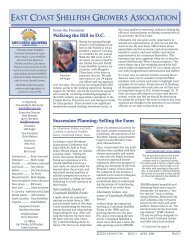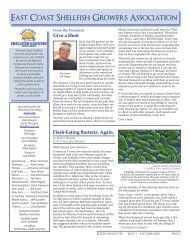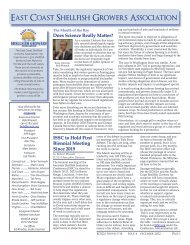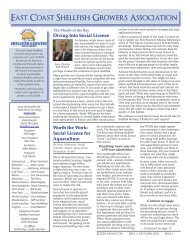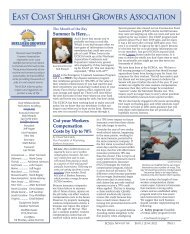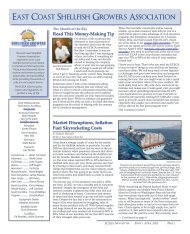East Coast Shellfish Growers Association August 2021 Newsletter
Read about the new disaster assistance for shellfish growers from the Farm Service Agency:ELAP; the death of Walt Canzonier; a win for South Carolina growers with help from allies; new biodegradable netting from Ketcham Supply; Prop 65 warnings; shellfish farm ecosystem services study.
Read about the new disaster assistance for shellfish growers from the Farm Service Agency:ELAP; the death of Walt Canzonier; a win for South Carolina growers with help from allies; new biodegradable netting from Ketcham Supply; Prop 65 warnings; shellfish farm ecosystem services study.
You also want an ePaper? Increase the reach of your titles
YUMPU automatically turns print PDFs into web optimized ePapers that Google loves.
Proposition 65 Could Cost
You Big Bucks
by Robert Rheault,
ECSGA Executive Director
If you sell products to California, you should
be aware of Proposition 65 1 , a law requiring
the labeling of products listed by the state as
causing cancer, birth defects or other reproductive
harm. A few fishery products have tripped
California’s strict limits on cadmium and lead,
resulting in eye-popping fines and settlements.
Proposition 65 was a ballot initiative voted into
law in 1986. The California Office of Environmental
Health Hazard Assessment (OEHHA) 2
now mandates that if a product (or the packaging
it is shipped in) might contain certain
chemicals, the package must have a label
describing what the chemical risk is and how it
might impact consumers' health.
Every year the list of chemicals 3 grows—it now
includes over 900 potential toxins and carcinogens.
Because it is California, the state decided
that the federal limits on many of the substances
are too lenient, and established much more
Advocates and Counselors Representing
Shellfish Growers Since 1999
SAMUEL W. “BILLY” PLAUCHÉ
billy@plauchecarr.com
MEGAN K. TERRELL
megan@plauchecarr.com
www.plauchecarr.com
Pacific Northwest Office
1218 3rd Ave., Ste. 2000
Seattle, WA 98101
206.588.4188
Gulf Coast Office
1110 River Rd. S., Ste. 200
Baton Rouge, LA 70802
225.256.4028
stringent limits for
products sold in
California.
Take cadmium for
example, a heavy
metal found in
soils and waters
all over the world.
In some places
cadmium levels
are naturally high, and certain shellfish can accumulate
enough that some regulators started
to have concerns. According to Prop 65, a seller
might be able to win a lawsuit by showing
that the presence of the metal is the result of
naturally occurring contamination as opposed
to a human (anthropogenic) pollution or food
additive, but it could be a heavy lift. New Zealand
is trying this argument after being cited for
cadmium in their green-lipped mussels, but it
is likely to cost them more to prove their case
than they would end up paying in a settlement.
In 2019 companies paid $30 million to resolve
2,410 claims (909 settlements) with the average
settlement coming in at around $35,000. For
the seafood industry most of the claims have
been for lead and chromium found in cooked
squid and shellfish
products
from Asia or
New Zealand,
but I did hear of
one West Coast
firm that was
nailed with a
$50,000 settlement
for cadmium
in smoked shellfish. One of the scarier
elements of the law is that private attorneys can
initiate legal action and take 25 percent of the
settlement, so it is a proven money maker for
certain types of ambulance-chasing lawyers.
The literature on most of the substances is dizzyingly
complex. You can find Environmental
Protection Agency (EPA) regulatory limits 4 for
some contaminants in some foods, but shellfish
are regulated by the Food and Drug Administration
(FDA). It's often the case that different
regulatory limits are cited by the FDA, the
EPA and the WHO-FAO Codex Alimentarius 5 .
Then for shellfish we have Alert levels, which
have no public health significance, but are just
one standard deviation above the mean and tell
regulators they need to be aware there may be
contamination in a particular harvest area if
the levels are tripped. We have Alert levels
of iron, copper and zinc, (all of which are in
my daily multi-vitamin) as well as mercury,
arsenic, chromium and cadmium. Then there
are Action levels that have been established
by the EPA for drinking water.
To comply with the Codex limit on cadmium,
shellfish meats must contain less than
2 ppm (or a tolerable monthly intake below
25 µg/kg of body weight.) The FDA says
the limit for cadmium in shellfish is 4 ppm.
California presents their Prop 65
limits as daily consumption limits,
which for cadmium should be
below 4.1µg/day. Depending on
how much you think people might
eat you are probably ok, but how
much can you afford to spend on
testing? Thankfully, an East Coast
Shellfish Research Institute study
conducted by Dale Leavitt in
2009 found that the levels of lead,
cadmium and mercury in clams
and oysters from up and down the
East Coast were well below the
levels that should cause concern,
unless they were harvested near
a superfund site, metals-plating
facility or Navy base.
Then there are the labeling requirements.
It's bad enough to
have to put a label on your products
saying it could cause cancer
or birth defects, but I have not
been able to get a clear answer
on what is required. Firms will
sell you generic labels, but some
elements of the regulation seem to
indicate that you have to explain
which substances are potentially
— Continued on page 13
Page 8 ECSGA Newsletter Issue 3 August 2021




